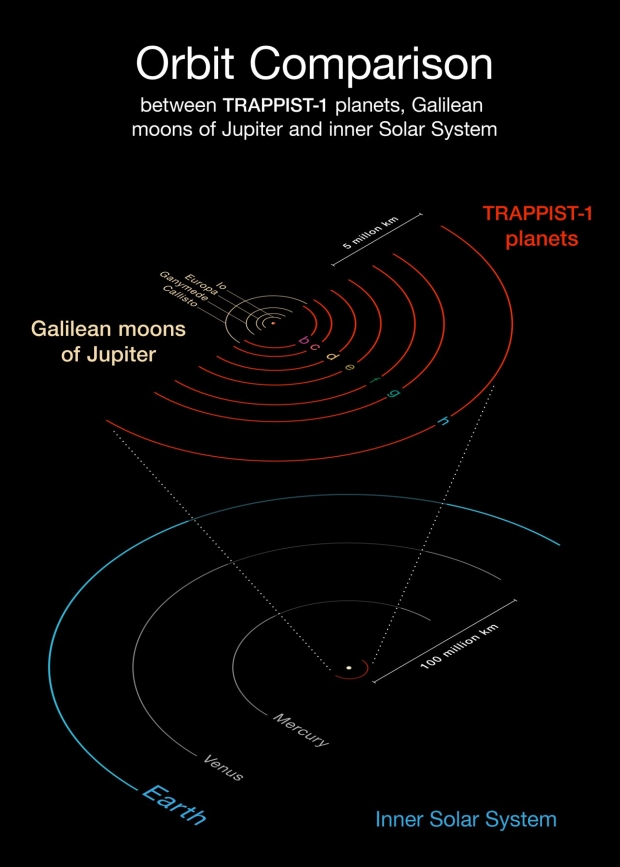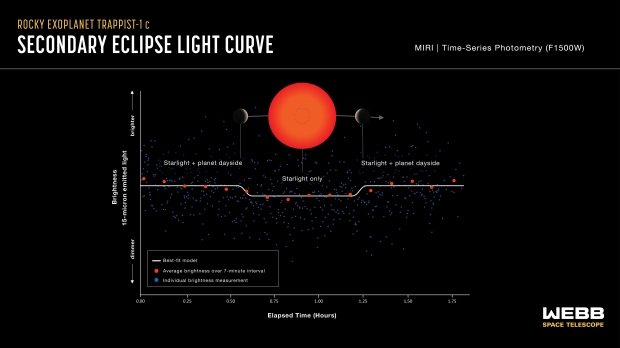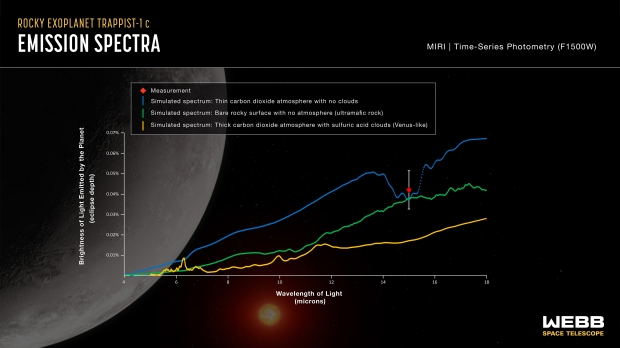It’s no surprise that the James Webb Space Telescope’s General Observers program should target TRAPPIST-1 with eight different efforts slated for Webb’s first year of scientific observations. Where else do we find a planetary system that is not only laden with seven planets, but also with orbits so aligned with the system’s ecliptic? Indeed, TRAPPIST-1’s worlds comprise the flattest planetary arrangement we know about, with orbital inclinations throughout less than 0.1 degrees. This is a system made for transits. Four of these worlds may allow temperatures that could support liquid water, should it exist in so exotic a locale.

Image: This diagram compares the orbits of the planets around the faint red star TRAPPIST-1 with the Galilean moons of Jupiter and the inner Solar System. All the planets found around TRAPPIST-1 orbit much closer to their star than Mercury is to the Sun, but as their star is far fainter, they are exposed to similar levels of irradiation as Venus, Earth and Mars in the Solar System. Credit: ESO/O. Furtak.
The parent star is an M8V red dwarf about 40 light years from the Sun. It would be intriguing indeed if we detected life here, especially given the star’s estimated age of well over 7 billion years. Any complex life would have had plenty of time to evolve into a technological phase, if this can be done in these conditions. But our first order of business is to find out whether these worlds have atmospheres. TRAPPIST-1 is a flare star, implying the possibility that any gaseous envelopes have long since been disrupted by such activity.
Thus the importance of the early work on TRAPPIST-1 b and c, the former examined by Webb’s Mid-Infrared Instrument (MIRI), with results presented in a paper in Nature. We learn here that the planet’s dayside temperature is in the range of 500 Kelvin, a remarkable find in itself given that this is the first time any form of light from a rocky exoplanet as small and cool as this has been detected. The planet’s infrared glow as it moved behind the star produced a striking result, explained by co-author Elsa Ducrot (French Alternative Energies and Atomic Energy Commission):
“We compared the results to computer models showing what the temperature should be in different scenarios. The results are almost perfectly consistent with a blackbody made of bare rock and no atmosphere to circulate the heat. We also didn’t see any signs of light being absorbed by carbon dioxide, which would be apparent in these measurements.”
The TRAPPIST-1 work is moving relatively swiftly, for already we have the results of a second JWST program, this one executed by the Max Planck Institute for Astronomy and explained in another Nature paper, this one by lead author Sebastian Zieba. Here the target is TRAPPIST-1 c, which is roughly the size of Venus and which, moreover, receives about the same amount of stellar radiation. That might imply the kind of thick atmosphere we see at Venus, rich in carbon dioxide, but no such result is found. Let me quote Zieba:
“Our results are consistent with the planet being a bare rock with no atmosphere, or the planet having a really thin CO2 atmosphere (thinner than on Earth or even Mars) with no clouds. If the planet had a thick CO2 atmosphere, we would have observed a really shallow secondary eclipse, or none at all. This is because the CO2 would be absorbing all of the 15-micron light, so we wouldn’t detect any coming from the planet.”

Image: This light curve shows the change in brightness of the TRAPPIST-1 system as the second planet, TRAPPIST-1 c, moves behind the star. This phenomenon is known as a secondary eclipse. Astronomers used Webb’s Mid-Infrared Instrument (MIRI) to measure the brightness of mid-infrared light. When the planet is beside the star, the light emitted by both the star and the dayside of the planet reach the telescope, and the system appears brighter. When the planet is behind the star, the light emitted by the planet is blocked and only the starlight reaches the telescope, causing the apparent brightness to decrease. Credits: NASA, ESA, CSA, Joseph Olmsted (STScI)
What JWST is measuring is the 15-micron mid-infrared light emitted by the planet, using the world’s secondary eclipse, the same technique used in the TRAPPIST-1 b work. The MIRI instrument observed four secondary eclipses as the planet moved behind the star. The comparison of brightness between starlight only and the combined light of star and planet allowed the calculation of the amount of mid-infrared given off by the dayside of the planet. This is remarkable work: The decrease in brightness during the secondary eclipse amounts to 0.04 percent, and all of this working with a target 40 light years out.

Image: This graph compares the measured brightness of TRAPPIST-1 c to simulated brightness data for three different scenarios. The measurement (red diamond) is consistent with a bare rocky surface with no atmosphere (green line) or a very thin carbon dioxide atmosphere with no clouds (blue line). A thick carbon dioxide-rich atmosphere with sulfuric acid clouds, similar to that of Venus (yellow line), is unlikely. Credit: NASA, ESA, CSA, Joseph Olmsted (STScI).
I should also mention that the paper on TRAPPIST-1 b points out the similarity of its results to earlier observations of two other M-dwarf stars and their inner planets, LHS 3844 b and GJ 1252 b, where the recorded dayside temperatures showed that heat was not being redistributed through an atmosphere and that there was no absorption of carbon dioxide, as one would expect from an atmosphere like that of Venus.
Thus the need to move further away from the star, as in the TRAPPIST-1 c work, and now, it appears, further still, to cooler worlds more likely to retain their atmospheres. As I said, things are moving swiftly. In the coming year for Webb is a follow-up investigation on both TRAPPIST-1 b and c, in the hands of the system’s discoverer, Michaël Gillon (Université de Liège) and team. With a thick atmosphere ruled out at planet c, we need to learn whether the still cooler planets further out in this system have atmospheres of their own. If not, that would imply formation with little water in the early circumstellar disk.
The paper is Zieba et al., “No thick carbon dioxide atmosphere on the rocky exoplanet TRAPPIST-1 c,” Nature 19 June 2023 (full text). The paper on TRAPPIST-1 b is Greene et al., “Thermal emission from the Earth-sized exoplanet TRAPPIST-1 b using JWST,” Nature 618 (2023), 39-42 (abstract).



“ All the planets found around TRAPPIST-1 orbit much closer to their star than Mercury is to the Sun”
As a space science civilian, this really surprised me, wondering just how stable these orbits could be over time. And how any instability would color speculation about life.
Yes, it seems remarkable, doesn’t it? But remember that everything is to scale. TRAPPIST-1 is a star only about 9 percent as massive as the Sun, and quite cool compared to G-class stars like ours. These planetary orbits are indeed stable, and several of the planets here may have habitable conditions. Because TRAPPIST-1 is only slightly larger than Jupiter, it’s easiest to imagine the analogy with Jupiter’s system of moons. Remember, too, that as much as 80 percent of the stars in the galaxy may be red dwarf stars, meaning the inventory of planets may tilt heavily toward them.
Wow – A great update
I’ll be looking forward to results from the other further out planets here as well.
Interesting comment Dennis I’m sure I have a paper saved in my Trappist1 folder explaining there orbital stability
and a quick glance revels over 70 saved papers on this steller system.
Two interesting articles worth reading are below.
Trappist 1C
https://webbtelescope.org/contents/news-releases/2023/news-2023-125
Trappist 1C
https://www.mpia.de/news/science/2023-08-trappist-1-c
I do share your passion here Paul great update.
Cheers Edwin
Thank you, Paul, and Edwin, for the very interesting links. A great update indeed! What a curious place this universe is.
Redistribution of heat is an important factor and also orbital variation factors play most significant role.we should determine how the plate movements influence Trappist1 C
The Trappist 1 system is over seven and one half billion years old. There might have been a lot of solar wind stripping of its original atmosphere. Also it is a smaller system and ours, so maybe got less water and atmosphere that our solar system? NASA’s article about Trappist 1-C and JWST’s thermal emission spectrum of it says that maybe Trappist 1-C might have started out with less water.
Regarding habitability, what we really need to know is what the d,e,&f, planets are like. Have the star’s flares also stripped their atmospheres, or are any of them intact? If those prove to be worlds without atmospheres, that must surely reduce the probability that M dwarfs are inhabited, and favorable targets due to their frequency.
In our system, if Mars should prove to have a deep crustal biosphere, that would leave the possibility that Trappist-1 planets, despite the loss of atmospheres, could be inhabited by subsurface microbes. It would be strange to think that most life in the galaxy was not only microbial but hidden in the crusts of rocky worlds. OTOH, if Mars proves sterile, and M dwarfs prove to have mostly HZ rocky worlds without atmospheres, then the probability of life elsewhere is reduced.
Indeed:
I’m starting to get really spooked by recent findings–a kind of loathing feeling that we might actually be ALONE in this vast universe.
It’s a really lonely frightening thought. :(
—————-
Essentially:
1) Mars’ surface seems likely sterile.
2) Europa’s oceans may be too hyper salty/saline for life.
3) Enceladu’s excess phosphorous that is not bound to organics and thus goes unused is also not exactly a great sign.
4) The lack of observed mega-engineering projects is also disappointing:
Moving stars in a galaxy to better facilitate empire travel times would be child’s play to an older advanced civilization, but again we don’t see this in any regional galaxies.
5) The lack of directed radio signals or radar pulses only adds deeply to this forlorn I feel–the icing on this cake of existential dread!
—————-
Anyways sorry to sound like a downer.
Maybe there’s still hope fir the other Trappist1 worlds. Either way we have to keep looking: it’s a big universe!
Mr. Radio:
I certainly take your point, but my reaction has been the exact opposite: I’m stunned by the incredible variety of environments we are discovering; some of these environments would not have even been postulated just a few years ago.
And we have only begun, really. Imagine what we will learn as the technology matures, allowing the discovery and examination of planets with earth-like orbits and solar exposure.
Even now, the TRAPPIST-1 findings are particularly intriguing to me because it identifies rocky worlds (8!) in such tight orbits. As Paul reminded me, one must put aside preconceived notions. The universe is a huge place.
It does look more likely that the early phase of the red dwarfs formation is more violent than we initially thought.
All of the Trappist worlds orbit close to a flare star thawt is an estimated 7 billion years old. I would be surprised if any of them retained an atmosphere in that environment, and I suspect this is the default state for most (if not all) rocky planets orbiting M dwarfs.
These (solar systems around M dwarfs) are interesting to observe, and there sure are a lot of them, but I have a hard time envisioning a system like this as the abode of life.Native life, anyway; a technical civilization might be able to settle such a system…although I have a suspicion that there’s a lack of volatiles in places like the Trappist system, and that might reduce the desirability of said real estate.
“a technical civilization might be able to settle”
This reminds me of a novel I read a few years ago; some sort of giant machine is on Mercury, slowly progressing on tracks around the planet, always staying centered on the terminator. But I can’t recall the book or author? Banks, perhaps?
ps: Paul, I’ve been commenting here for some years, and the darn site refuses to save my login credentials. I don’t mind each time but thought maybe you’d like to know.
Yes Michael,
You do raise a great point in that the Trappist 1 system is simply a sample of… 1.
A sample of 1 in such a vast universe is perhaps rather insufficient and premature to cause my negative existential dread that we might be alone.
In fact it’s not even a sample of 1: they’re not finishing analyzing the data and sending out the results!
But still… I would have thought we’d have found at least some tangible sliver of alien life, in all our decades of searching, by now?
I suppose the seasonal methane spikes on Mars–which continue to give me some hope–might be the strongest signal of possible alien life we’ve encountered thus far? So there is that, which I’m hanging onto.
But ya, I would have thought we would have had stronger evidence than that by now…
I suppose I’m just in a mind frame right now in which the pendulum has swung the opposite direction too far!?
(Previously I was absolutely convinced there was probably alien life everywhere, the opposite direction of the pendulum swing.)
Recall Jill Tartar: our SETI efforts to date are as a thimble of water among the oceans of Earth (paraphrasing correctly, I hope).
Given the enormity of the universe, advanced life is far more likely than not.
Kim Stanley Robinson’s “2312”?
Yes, I think so.
“site refuses to save my login credentials”
They are saved in a cookie on the local (client) device. If the local system blocks writing of some or all cookies – or deletes them – then the credentials will not be saved.
If our neck of the universal woods is demonstrated to be rife with microbes — but for anything more complex, having us stand out as a lone sore thumb — one possible explanation is that we, by the luck of the draw, are past a Great Filter.
The absence of advanced technologies such as electromagnetic spectrum broadcasts and megastructures may reflect inadequacies of our detection methods, but here again there may be another Great Filter, this one ahead of us, and therefore not necessarily neutral in what it bodes us.
Perhaps the water was lost early on like Venus and the thick co2 envelope developed. But once the greenhouse effect of the water is gone maybe the co2 reacted with soil to form a carbonate rock leaving a nitrogen atmosphere behind.
As noted by several above, “Well, that takes care of b…”. And that is more or less the case. But one might consider it analogous to Mercury. Or Io without the vulcanism. In either case, the successive planets might have features that will make them quite distinctive. And that could include a detectable atmosphere, perhaps on the outer edge of the “swarm”.
In the case of Jovian system, the geologic evolution of the Galilean moons is quite distinctive. Some of it is due to similar period harmonics that pluck the satellites like strings. Io’s volcanism, Europa’s ice sheet over a deep ocean and Ganymede with apparent tectonics with Callisto less differentiated – or hardly at all – through and through. And Jupiter itself, was not always the same temperature or radius it is now either.
Verifying whether the Trappist system is uniform, similar to the four Galilean moons or Sol’s terrestrial planets – it’s still early in terms of observation with time and means at our disposal.
An analogous situation, perhaps, was the picture painted of Mars – by Mariner IV. Later views did not fulfill all are expectations, but the planet had more to offer as an abode for life than what it had first shown.
The inner planets may have been hit by 1-2-3 knock out punchs, extreme tidal heating and early high proto star radiation forcing water vapour high into atmosphere where the high UV irradiance removed the water. Water vapour is a powerful greenhouse gas and once removed, this red dwarf has had time to do so, the carbon dioxide atmosphere would react directly with the ground even at the temperatures indicated. Not sure how a nitrogen spectrum would look like but not far of a barren rock one would think.
https://www.ldeo.columbia.edu/gpg/projects/carbon-sequestration